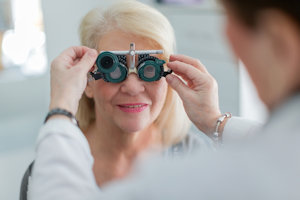Laser Cataract Surgery vs Traditional
If you are considering cataract surgery and comparing traditional surgery vs. laser cataract surgery, Elmquist Eye Group can help you understand your options.
The Evolution of Cataract Surgery

Cataract surgery is one of the world’s oldest surgical procedures, but has evolved over the centuries. The first documented procedure was in the 5th Century BC and involved striking the cataract with a blunt object to dislodge it. Although the cataract was removed, limited but unfocused vision was restored.
The first surgical removal of a cataract occurred in 1748 in Paris. The procedure required a very large incision and no artificial lens was implanted. Fine sutures did not exist at the time, so patients were immobilized with sandbags around their heads while the wound healed, and relied on Coke- bottle-thick glasses to see.
Thankfully, phacoemulsification surgery was introduced in 1967 and enabled eye surgeons to break up a cloudy cataract into tiny fragments and suction it out through small incisions. This revolutionized cataract surgery, leading to smaller wounds and faster recovery times.
Smaller incisions required flexible intraocular lenses (IOLs), and manufacturers began making them with materials such as acrylic and silicon. These lenses could be folded to fit through the tiny incisions.
Traditional Cataract Surgery
Today, traditional cataract surgery involves making a tiny incision on the side of the cornea to remove the cataract-clouded lens. This is done by using a hand-held instrument with a metal blade. Then, using phacoemulsification, ultrasound waves break up the cataract so it can be suctioned out. Once removed, an artificial IOL is inserted to replace the natural lens. The corneal tissue then heals itself without the need of any sutures.
Laser-Assisted Cataract Surgery
Laser technology can now be used to perform many of the traditional cataract surgery steps. 3D imaging allows the surgeon to map out the unique characteristics of your eye and cataract so that very precise incisions can be made. Instead of a hand-held instrument, the surgeon uses a special laser to make the incision in the cornea as well as to break up the cloudy lens and remove it. Laser-assisted cataract surgery is incredibly accurate and provides for quick recovery and the best visual outcomes possible.
Whether traditional or an advanced laser-assisted cataract surgery is right for you depends on many factors, all of which can only be assessed by your cataract surgeon. Both procedures are extremely safe, common, and have high success rates.
Yasaira Rodriguez, MD, Kate Wagner, OD, and, Nina Burt, OD provide complete eye care services for all members of your family, from children to seniors.
Dr. Rodriguez is a skilled, board certified ophthalmologist and surgeon, and Drs. Wagner and Burt are board certified optometrists. With state-of-the-art facilities, we can help you achieve the best possible visual results from your cataract surgery.
If you have questions about laser cataract surgery vs. traditional surgery, the doctors at Elmquist Eye Group are among the best qualified to answer them. Get in touch with us today at (239) 936-2020 to schedule an evaluation.
